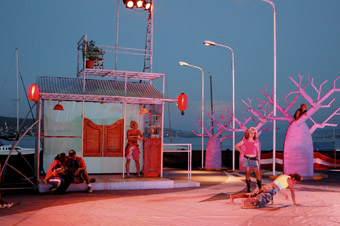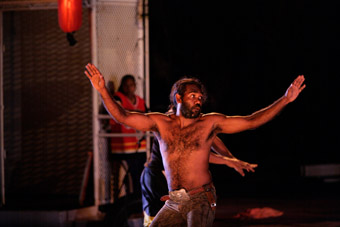indigenous & cosmopolitan
keith gallasch: interview, rachael swain, burning daylight

Burning Dayight in Zurich 2007, Marrugeku
photo Christian Altorfer
Burning Dayight in Zurich 2007, Marrugeku
BURNING DAYLIGHT, A MAJOR DANCE THEATRE WORK FROM INTERCULTURAL PERFORMANCE COMPANY MARRUGEKU, HAS HAD A VERY LONG GESTATION, INCLUDING A COUPLE OF PREMATURE APPEARANCES, OR “AVANT PREMIERES”, AS ARTISTIC DIRECTOR RACHAEL SWAIN CALLS THEM, ALONGSIDE HER OWN VENTURE INTO MOTHERHOOD AND THE DEVELOPMENT OF NEW WORKS—FOR BOTH MARRUGEKU AND STALKER, OF WHICH SWAIN IS ALSO AN ARTISTIC DIRECTOR.
Not surprisingly, when I phone Swain, she describes her current state as “crazy.” 2009 has been a year of working “on the floor”, she explains, while “2008 was at the desk”, organising tours and doing preparatory work for 2009. “That’s how it works now”, Swain declares with just a hint of ambivalence, “some years on the floor, some not.” This is not surprising given the scale and international ambitions of her productions.
Burning Daylight will achieve its apotheosis in Broome in late October and then tour to Perth, Melbourne, Sydney and Hobart in November. Before that Swain is developing Shanghai Lady Killer for Stalker, with film director Tony Ayres among her collaborators, and pulling off Marrugeku’s first International Indigenous Choreographic Workshop in partnership with Sydney’s Critical Path choreographic laboratory.
Swain established the Marrugeku Company in 1994 with the particular aim of engaging with both Australian Indigenous culture and an enlarged vision of performance entailing dance and multimedia. Mimi (1996) and then Crying Baby (2001) were developed with traditional Aboriginal communities in the Northern Territory and successfully performed there, around Australia and overseas. For Stalker, Swain directed Incognita (2003) and was commissioned by the European Capital of Culture to create Sugar, an intercultural dance project, in the cities of Marseilles and Liverpool in 2006-07.
Since I saw an early work-in-progess version of Burning Daylight in 2005, the work has had two more developments in Broome, including the shooting of three short films (by Warwick Thornton, director of Samson and Delilah), which are integrated into the work. An ‘avant premiere’ was staged for the 2006 Shinju Matsuri Festival in Broome and a documentary on the making of the work was screened on ABC TV. Burning Daylight would have been fully realised earlier than late 2009, says Swain, but for a shift in funding timelines in WA and the collapse of plans to tour Europe in 2007. Nonetheless, it was performed in the ‘avant premiere’ version at the last of Maria Magdalena Schwaeggerman’s Zurich Theatre Spektakls where it was well received. The final realisation of the work has been aided by the West Australian Government’s Department of Culture and the Arts’ new Major Production Fund, Ignite.

Trevor Jamieson, Burning Dayight in Broome, Marrugeku
photo Rod Hartvigsen
Trevor Jamieson, Burning Dayight in Broome, Marrugeku
Swain describes Burning Daylight as having three main stories. “Set outside a karaoke bar the show reflects the first story, the contemporary reality of the young in Broome, late night Thursday or Friday or Saturday on the streets. The karaoke video screen reveals a second story, the history of the town, with the onstage characters portraying their grandparents—a world of the White Australia Policy and forced removals.” The third story, she says, “emerges between street and screen…a ghostly present.” She felt this ghostliness as palpable during the development of Burning Daylight in Broome where “the shadow of the testing of a Native Title land claim had a big effect on the community, and on the storytelling and dance in the show. It meant that we were not allowed to work with the traditional stories of the Indigenous community. So, the ghosts came out, an implicit dialogue about what haunts Indigenous people when land and story are lost.” She says this can be felt strongly when Trevor Jamieson and Yumi Umiumare perform the Ikebana Tango while the screen reveals their grandparent lovers: a stockman and a geisha (Japanese pearl divers have played a significant part in Broome’s history).
Swain says that alongside modern Broome, Burning Daylight evokes the older town, once regarded as “an Asian wild west”, and characterises Thornton’s contributions as “karaoke noodle western videos.” The contemporary aspect will be heightened with music by MC Dazastah of Perth-based hip hop crew Downsyde. As well as Trevor Jamieson (of Ngapartji Ngapartji) and butoh dance performer Yumi Umiumare, the cast includes Sydney dancer Kathy Cogill, Sermsah Bin Saad (Suri), a So You Think You Can Dance finalist, and Broome-born dancer Antonia Djiagween.
Compared with its antecedents, Burning Daylight has become, like Broome itself, a more cosmopolitan mix of collaborating artists. I asked Swain how this came about. After the tours of Mimi and Crying Baby, Swain explained, she found herself wondering about European expectations of Aboriginal dance, particularly in northern Europe where there was “a lot of hype around traditional dance. I wanted to make something more playful and diverse, to say, ‘this is contemporary aboriginality, cosmopolitan and global, but with a deep connection to the land’.” To break from stylistic constraints, Swain invited West African artist Serge Amié Coulibaly (founder and Artistic Director of Faso Danse Theatre, based in Ouagadougou, Burkina Faso and a collaborator with Belgium’s Les Ballets C de la B) to “workshop a new way for Marrugeku”, with what was essentially a new company in a different community, Broome, “to join the dots between Aboriginal dance and contemporary performance.” It was an opportunity “to reconceive the intercultural process. It took Dalisa Pigram and I two years just to get our heads around the piece and how to realise it in the much more hybrid context of Broome. It took a long time and was like learning a whole new language. It felt like a beginning, a new beginning for Marrugeku.” Pigram, a performer and founding member of Marrugeku comes from the Yawuru people of the Kimberley, and is co-choreographer of Burning Daylight with Coulibaly.
In RealTime 92, Bangarra Dance Theatre’s director Stephen Page asked where were the other dance opportunities for Indigenous artists outside his company. Marrugeku is addressing the issue in several ways: in its own productions, through a dance laboratory and in a training workshop for 10-20 year olds culminating in a production, Buru. The International Indigenous Choreographic Laboratory is a three-year project that Swain considers a logical extension of Burning Daylight. Curated by Swain and Pigram it’s inspired by an “empowering West African-European model that embodies resonance and difference.” Serge Amié Coulibaly will lead the first workshop in October, which includes Indigenous Australian and Maori participants.
Buru will be a new Marrugeku production in 2010 coming out of training workshops for 10-20 year old Indigenous participants gathering across their school holidays. There’s also a solo work for Dalisa Pigram in development and Swain is hoping a new Marrugeku work for adults might emerge from this year’s Choreolab to be worked on in 2010.
As for Burning Daylight after its Australian tour, Swain says, “It’s difficult to know in a global economic recession. US festivals are keen but often don’t know their budgets until very late.” In the meantime, development and diversification are firmly on the agenda. She welcomes the prospect of having a smaller work like Pigram’s in development, given “the enormous amount of time and the expense of working in remote communities on the big projects. We need a broader portfolio.”
Swain’s personal life, sometimes “a big juggling act”, she says, but inseparable from her art, has changed significantly since the earliest incarnation of Burning Daylight. Two weeks before the first ‘avant premiere’ of the show she gave birth to a daughter, Jade Jet, who arrived on schedule and, four days later, Swain was back in rehearsal. Resonating with the show’s local culture cosmopolitanism, the child’s grandfather, of Chinese descent, was born in Broome and her great grandfather had lived there too.
Marrugeku, Burning Daylight, Mobile States tour: Goolarri Outdoor Venue, Broome, Oct 28-31; PICA, Russell Square, Northbridge, Perth, Nov 4-7; CarriageWorks, Sydney, Nov 11-14; Arts House, Meat Market, Melbourne, Nov 18-21; Princes Wharf, Hobart, Nov 25-28; Performing Lines, www.performinglineswa.org.au
RealTime issue #93 Oct-Nov 2009 pg. 10






